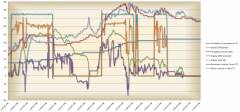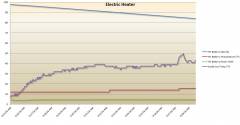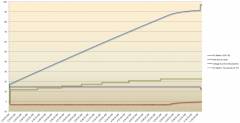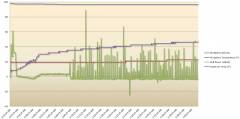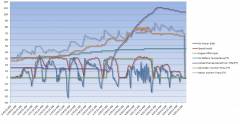

larryh
Fusion Energi Member-
Posts
1,462 -
Joined
-
Last visited
-
Days Won
152
Content Type
Gallery
Profiles
Forums
Everything posted by larryh
-
From the album: Car
This graph shows an 8 mile trip that involves a couple of relatively steep 15% grades. Outside temperature is 3 F. -
It was the fuel door fault that caused the Service Engine Soon light to come on. The light is now off and I no longer see the DTC. It showed some notification or other on the display when I was stuck in the snow. I didn't catch what it was. I am assuming that was what caused the other DTC.
-
I wonder how the car maintains constant load and rpms on the ICE regardless of the speed and power demands that I place on the car. Can it adjust the transmission almost instantaneously to changes in power and speed to maintain a constant ICE operating point of 1500 rpm and 65% load? Or rather than directly providing torque to the wheels, is it simply running the generator at that constant speed and load to provide a fixed amount of power for the electric motor to propel the vehicle. The remaining power required comes from the HVB.
-
The scanner does collect quite a bit of information. I don't know anything about the CAN bus or its bandwidth, and how much data and at what rate it is safe to collect from a scanner. The snow drifted in around my car, so I had a hard time getting out. I was suspecting that this might have had something to do with it. I don't know what the difference is between a Pending fault (for the fuel door) vs. a History fault (for the comm error) is. I wonder which one is causing the Service Engine Soon light.
-
I am now recharging after a trip this afternoon that warmed the HVB to 55 F. This time the Kill-A-Watt meter says the charger is consuming 1400 kW of power. So power used to charge the battery varies with temperature. I also notice the Service Engine Soon light came on. I saw the following DTCs: P04B5 - Fuel Fill Door Stuck Open U0412 - Invalid Data Received From Battery Energy Control Module A The description for the first one states: P04B5: 1) Mechanically stuck (door open) or customer did not close fuel door. No indication to close FTIV after refueling. Well, we bumped the button on the console to open the fuel door. So that explains that DTC. But I don't know what the second one is about. Some network communication error from the battery control module in the Auxiliary Emission Controls System. This DTC is applicable to most ford vehicles so it is not referring to the HVB control module.
-
The following graph is for an 8 mile trip I made this afternoon which involves a couple of relatively steep 15% grades. The outside temperature was 3 F. You can see regenerative braking occurring at about 1:37, 1:44, and 1:48 for stop lights (the purple line shows negative power, i.e. power being applied to the HVB). The electric heater was on most of the time consuming about 5 kW of power. You can see that when the speed is 0, i.e. at time 1:44. I used hill assist from about 1:42 to 1:44 going down a steep hill. You can see the temperature for both the motor and generator inverters rising. Hill assist must be using both the generator and the motor for regen. When I applied the brakes at the bottom of the hill, the motor inverter temperature spikes. The motor is doing the regenerative braking. At about 1:45, I began accelerating up a steep hill. You can see the HVB temperature rising relatively quickly while the HVB provides up to 45 kW of power. The generator inverter temperature also rises rapidly while going up the hill. This suggests the ICE is running the generator to power the motor. Finally, as expected, the motor inverter temperature rises rapidly as the electric motor is doing most of the work to get up the hill. The ICE was doing about 1/4 the work of the electric motor on the Engage display. The ICE came on four times. All the time it was on, it ran at a steady 1500 rpm. In addition, the load on the engine was generally around 65%. This must be its favored operating point. Even when accelerating up the hill, the ICE still ran at 1500 rpm and 65% load. The HVB provided the power to the electric motor to make up the difference. Only on the return trip, after the HVB was depleted, I see the rpms and load on the ICE vary. I general, the generator inverter temperature rises when the ICE is running. This implies the ICE is running the generator. It also rises during Hill Assist, so the generator is used for regen in Hill Assist also. The motor inverter temperature rises during acceleration, braking and Hill Assist. The motor is used to propel the vehicle and to provide regenerative braking and regen in Hill Assist.
-
This diagram shows the performance of the Electric Heater when the ambient temperature is 3 F. The car is plugged into the 120 V charger and turned on in EV Now mode for 13 minutes. Climate control is on. So basically, only the electric heater for climate control is consuming power. The HVB temperature rises from 12.2 F to 15.8 F. The HVB SOC falls from 97.7% to 83.9%. The interior temperature rises from 6.8 F to 42.8 F. I think the electric heater needs help from the ICE to warm up the car. The heating element consumes 4.8 kW of power from the HVB as reported by the OBD II scanner. However, the left display says the heater is consuming 5+ kW of power. The remaining power must be supplied by the 120 V charger plugged into the car.
-

Electric Heater Performance for Ambient Temperature of 3 F
larryh posted a gallery image in Member's Album
From the album: Car
This chart shows the performance of the Electric Heater with an ambient temperature of 3 F. The car is plugged into the 120 V charger and turned on (EV Now mode) with climate control enabled. -
This morning it is 3 F outside. The HVB temperature is 14 F. Using the 120 V charger, the Kill-A-Watt meter shows the charger only drawing 910 watts of power. It usually draws 1365 watts when the HVB is warm. The HVB SOC is 85%. The power that makes it to the HVB is 660 watts. So it looks like the charger in the car doesn't draw as much power when the HVB is cold.
-
The car consumes about 3.425 kW of electricity when charging. The fans and electronics in the car typically use about 70 watts of power. So that means 355 watts are lost by another process. I would assume that the charger uses a rectifier to convert AC to DC. Is 3000/3355 = 89.5% a typical efficiency for a rectifier? I also assume that there is a loss of power for the reverse process using an inverter to convert DC to AC. When computing the 82% efficiency ratio, where 82% of the power that comes from the wall outlet using a 240 V charger is actually used to propel the vehicle, that ratio must take into account not only the charging/discharging efficiency of the battery, but the rectifier and inverter efficiencies as well. So if the overall efficiency is 82%, and 89.5% efficiency for the rectifier alone is correct, then the rectifier would be one of the biggest sources of losses. Or is the plug-in energy reported by the car measured before the inverter, so the 82% ratio does not include the inverter efficiency? In that case, 82% of the electricity from the wall outlet does not actually make it to the wheels and the true efficiency is lower than 82%.
-
I received further clarification from the authors of the article at http://insideevs.com/infographic-fleetcarma-cold-weather-fuel-efficiency-electric-versus-gasoline-showdown/: The main reason is that aero represents a larger fraction of the load on an EV. Setting aside powertrain losses and auxiliaries, the loads can be put into three main buckets: aero, rolling, braking. In an EV you recoup a portion of the braking through regenerative braking. So the effects of aero and rolling have a larger share of the "load pie" in an EV. So denser air increasing aero losses will have a disproportionately bigger impact on an EV than on an ICE. So you may not have expected it, but the answer to why EVs are proportionally more impacted by aero drag in cold weather is: ...because of regen
-
I'm going to guess that because the HVB temperature is only 23 F, it can no longer provide 7.6 kWh of energy. That might explain the discrepancy. The EV range is currently 16 miles, far less than the normal 25 miles in summer.
-
From the album: Car
The SOC, temperature, and power applied to the HVB when charging using a 240 V charger. Also shown is the 12 V battery voltage. -
Yes, Torque Pro app allows you to record any data being read by an OBD II scanner. It saves the data in a CSV file which I then email to myself and read into Microsoft Excel. Torque Pro works with several USB, WiFi, or BlueTooth scanners and costs $4.95. My ELM327 scanner (which I bought 3 months ago and never used until now) connects to my Android device using WiFi. To do the charging and preconditioning plots, I simply connected the Android device in my house to the scanner in the car via WiFi, ran Torque Pro, and recorded the data. There is no user manual for Torque Pro, so it requires a great deal of effort to figure it out. Torque Pro is the only application that I know of that records the data. If you have a notebook computer, you can use BlueStacks, which emulates the Android operating system, to run Torque Pro. That's what I have been doing. You can buy a $60 Android tablet PC from Amazon.
-
The following chart shows the HVB SOC, HVB temperature, and power supplied to the HVB while charging the car using a 240 V charger. Also shown is the 12 V battery voltage (Control Module Voltage). The temperature in the garage was 12 F. The HVB battery temperature at the start of charging was 12.2 F. The temperature rose to 23 F by charge completion. The HVB SOC at the beginning was 17.354% and at completion, it was 91.58%. Right after charging completed, the SOC jumped to 97.18%. It decided it miscalculated the SOC? Charging began at 3:17 AM and finished at 5:23 AM. It took 2 hours and 6 minutes. During the entire period, the 12 V battery voltage was 14.8 V. It then dropped to 12.6 shortly after completion. So the 12 V battery was apparently being charged the entire time. The power applied to the HVB during charging was 3.00 kW. The charger was consuming 3.4 kW. So 400 watts was being used for something other than charging? A total of 5.62 kWh of electricity was supplied to the HVB. Something doesn't add up. The SOC increased by 97.18% - 17.354 = 79.826%. If the capacity of the HVB is 7.6 kWh, then the added energy was 7.6 * 79.826% = 6.066 kWh. It was only supplied 5.62 kWh. I will have to investigate further.
-
The following chart shows the HVB temperature, cabin temperature, HVB SOC, and power into the HVB while preconditioning the car using a 240 V charger. The temperature in the garage was 3 F. Outside it was -15 F. Preconditioning started at about 4:50 am. The GO time was at 5:45 am. The HVB temperature was 19.4 F when preconditioning started and 23 F at the GO time. The cabin temperature rose from 8.6 F to 48.2 F. The HVB SOC went from 98.4% to 96.9%, a small decrease of 1.5%. The units for power into the HVB is 100 watts. So the tall spike of 90 at 5:12 am corresponds to 9.0 kW. Negative values are power into the HVB. Positive values are flows out of the HVB. It looks like the car likes to send bursts of energy to the heating element and then rest for a while to recharge. I wonder if that is the intended design. Most of the interior temperature rise occurs at the beginning with a longer initial burst of energy to the heating element. Note that this chart shows the net flow of power out of the HVB. All the time the 240 V charger is supplying about 3.3 kW of power to the HVB. So there is an additional 3.3 kW of power being supplied to the heating element from the charger. A total of 2.8 kWh of electricity was consumed for preconditioning.
-
From the album: Car
This chart shows the HVB temperature, cabin temperature, HVB SOC and power flow into HVB while preconditioning when ambient temperature is 3 F. -
The criteria in my previous post that determines when the ICE starts is incomplete. Today it was -15 F outside. It was 3 F in the garage. I used the EBH. It warmed the coolant to 82.4 F after 3.5 hours. After driving 2 miles in EV Now, the car disabled EV Now and EV Later. I could no longer select them. The engine coolant temperature was 71.6 F at that point. When the coolant temperature dropped below 10 F the other day, the EV icon turned yellow to temporarily disable EV operation. After the coolant temperature rose above 100 F, EV operation was re-enabled. The EV Now and EV Later modes were still available to be selected. This time, I could no longer select EV Now or EV Later. There must be some other criteria that is used to completely disable EV Now and EV Later operation. I was now in EV Auto mode. I continued in EV until the ICE turned on when the coolant temperature was 57 F. This occurred at about the same point in my commute as the other day. The ICE ran about 3 minutes until the coolant temperature exceeded 105 F. Because the coolant was warmer, it ran about one minute less. It consumed fuel at the same rate as the other day.
-
First I need to establish a baseline for the car to understand how effective grille block is and any impacts on the car.
-
This is the same 8 mile commute at -12 F posted above. This time, I added engine coolant temperature, generator inverter temperature, and motor inverter temperature, all in degrees F. The things to note are that the ICE turned on as soon as the engine coolant temperature fell to 10 F. It then turned off after the engine coolant temperature reached 100 F. The generator inverter temperature rises significantly during acceleration. Is it assisting the electric motor? The ICE is not on so why else would the generator be running? Or is heat from the motor inverter radiating to the generator inverter? The generator inverter temperature also rises significantly when the ICE is on and the car is moving, but is steady while the ICE is on and the car is not moving. That strongly suggests the ICE is driving the generator to generate electric power for the electric motor to propel the vehicle. You will also notice that the power drawn from the HVB is less than half what is was before the ICE turned on when the vehicle is moving. I wonder what the split is between the ICE running the generator to power the electric motor to drive the wheels indirectly vs. providing power directly to the wheels. The motor inverter temperature rises significantly during regenerative braking and acceleration, as would be expected, when the most power is flowing through the motor. I believe the motor operates in reverse as a generator for regenerative braking.
-
From the album: Car
This is my 8 mile commute at -12 F showing various sensor temperatures. -
The ICE used about 0.12 gallons of gas. You can get the ICE to turn off sooner if you temporarily turn off climate control and reduce speed when the coolant temperature is above 100 F. You might be able to reduce it to about 0.08 gallons. But if it won't let you back into EV Now mode, then you might be stuck. I will have to figure out where that is on the temperature gauge on the left display.
-
If you are looking at the trip summary, the display truncates the gallons of gas to one decimal point. I use the trip odometer to provide a more accurate measurement. The actual amount could be 0.19 and the trip summary would show 0.1. You would have to have used about 2.8 kWh of electricity for your 5.3 mile commute to get 29 MPGe with 0.1 gallons of gas. I don't use that much electricity for my 8 mile commute, but then I don't need much heat on the way to work after preconditioning.
-
The lowest price I was quoted for a standard EVSE installation was about $325. So you are getting a very good deal. Bosch arranged the electrician for my installation that included a 3 year warranty. But my installation was complicated, involving a separately metered circuit. It took the electrician all day. The materials alone cost $400 for my installation.
-
I suspect that the engine coolant temperature determines when the ICE comes on. This is what I have observed for the past two days using EV Now mode and no heat. Yesterday morning, I drove in EV mode until the coolant temperature fell below 10 F. As soon as that happened, the ICE turned on. This morning, the coolant temperature only fell to 15.8 F and the ICE remained off. Yesterday afternoon, the coolant temperature was just below 0 F when I left work. The ICE turned on immediately. This afternoon, the coolant temperature was 3.2 F when I left work. The ICE turned on at exactly 2.0 miles from work. My conjecture so far is as follows: When you start out from a frequent destination, the ICE starts immediately when the coolant is below 0 F. When it is between 0 F and 10 F, you get to drive 2.0 miles in EV mode before the ICE turns on. If it stays above 10 F, you can run in EV mode. However, as soon as the coolant temperature falls below 0 F, the ICE turns on. Once the ICE turns on, it remains on until the engine coolant temperature exceeds around 100 F. If the engine coolant temperature falls below about 70 F, it comes on again. This all assumes the heater is off. I'm not sure how it works with that turned on yet. So, to stay in EV mode, I think you want to keep the ICE as warm as possible. A heated garage or an EBH.
